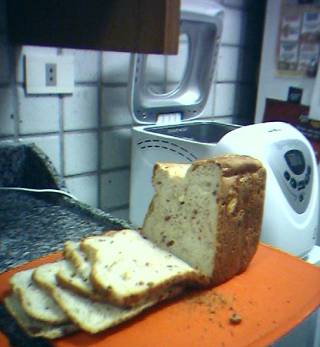|
 The versatile bread machine and its product.
The versatile bread machine and its product.
|
The Bread Maker Machine
Rec 21-apr-2007 16:33
About two months ago I bought a
Model 5891
breadmaker machine (sold here in Brazil by
Britânia as model
Multi-Pane)
as a birthday gift to myself.
The machine is just perfect for people lacking cooking skills like me: all you've
got to do is toss the ingredients in the baking pan in a certain order
(liquids first, flour and yeast last, don't let the yeast touch the liquids),
press a few buttons to set the desired bread type and wait. The baking pan
has this paddle that mixes the ingredients and does all the hard word of
kneading the dough. It's fun to watch the mixture become ball-shaped as the
machine shakes and makes rumbling noises.
Depending on the selected program (called "cycles", as in washing machines),
there are one or more resting periods to allow time for the
Saccharomyces cerevisiae
to metabolize the sugar and generate the carbon dioxide that makes the dough rise.
In the final phase, a resistor in the body of the machine is turned on and the
dough gets baked. The entire process is automatic, requiring no intervention.
Certain recipes may entail opening the lid at specific points of the process
to add other ingredients. We can make corrections as well: if the dough is too
dense, adding a tablespoon of water gets it back on track. If it gets too wet
and sticky, it is enough to sprinkle an extra tablespoon of flour.
The "expressbake" cycle gets the job done in 58 minutes, but the loaves tend
to get short and dense. In my opinion, the best loaves come out of the
"sandwich" cycle, which takes about three hours.
The machine beeps during key points of the process and when the bread is done.
The removable pan makes it very easy to take the bread out, which turns out
roughly the shape and size of an
italian panettone,
except for a hole in the bottom caused by the paddle (which sometimes gets
embedded in the bread, but it's trivial to take it out). It is better to slice
it with an electric knife so it's easier to achive an uniform thickness and
minimize crumbs. Its a lovely sight: the water vapour makes that "smoke" we see
in margarine ads.
If the recipe doesn't have anything that spoils quickly (such as eggs), we
can just dump the ingredients at night and program the timer to get it ready,
say, at 7am next morning. Since then, my alarm clock has become the smell of
freshly baked bread that spreads over the apartment.
The recipes in the
manual are
OK, but much better stuff can be done. Here's the recipe for my "standard
bread":
- 8 oz of water
- 1.5 teaspoons of salt
- 2 tablespoons of sugar
- 1 tablespoon of powdered milk
- 2 cups of wheat flour
- 1 cup of rolled oat
- 2 teaspoons of instant active dried yeast
- 1 teaspoon of dough enhancer (optional)
Prepare using the "sandwich" cycle, set to size I (1.5lb).
(I still haven't figured out exactly what the dough enhancer is made of.
There's
this store here in Recife that
sells it for most bakeries but it didn't cross my mind to ask at the time
we bought it.)
Given that homemade bread doesn't have additives, it goes stale faster than
the ones you buy in the supermarket or the bakery.
There are many web sites
specializing in bread machines
where you can get all sorts of info, recipes, etc. Here in Brazil some people
set up a
mailing list and even
an Orkut community to exchange tips, tricks and their own recipes: condimented
bread, panettone, jam, pizza dough. From those we learned tricks about minding
the air temperature and humidity: when we close the windows at night, the
bread turns out much better in the morning. We're told altitude also makes a
difference, but here in Recife we are at sea level, so it's a non-issue.
Those sites have many stories, both of sucess and failure, of satisfaction and
frustration. For us here, the overall experience has been positive. There
were some instances where the bread didn't turn out the way we wanted and
there were even a couple of experiences where it was outright inedible.
But they are the exception, not the rule. I can remember four failed
instances. But I lost count of the dozens of times everything went just fine.
Cleaning is easy: the antistick coating of the pan and paddle often makes them
get out almost clean in the end. All you've got to do is wipe them with a wet
cloth and wash them once in running water once a week. Just take care not
to get the outer metallic base wet because it rusts rather easily, or so
the manual says.
I read about some people complaining that the crust gets too thick and/or
dark. Sometimes it does happen, but we don't mind. And in the sandwich cycle
it rarely happens -- after the bread cools the crust softens, becoming
indistinguishable from sandwich bread from the supermarket.
Other people complained that the slice is too big for most toasters. To me,
this is nothing that cutting it in half won't fix.
I bought mine in a sale for R$ 264.00, or about US$ 130.00 at the time -- more
than twice as much as in the US! Even so, a cost-analysis calculation showed
that it would pay by itself in about nine months, given our usage habits in
comparison to a similar (somewhat expensive) bread we used to buy.
So, we've got hot fresh delicious economic bread almost every day with a minimum
of fuss. What else can I want? Definitely recommended!

